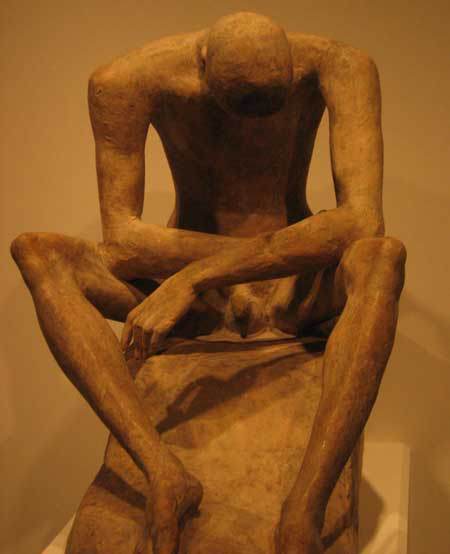
Is this really art? Snapped @ the Nat’l Museum of Art in DC
Directly following a post with extremely beautiful women who have bodies that, by some, can be considered works of art, it’s only appropriate that we move to a study on a theoretical definition of art. Yes, this is a damn long essay, but it’s not meant to be read in one shot. Print it out and read it next time you’re on the crappah. I’m not saying I agree with everything, but I think the man has a point.
On Art, by Tolstoi
What is and what is not Art, And when is Art important, and when is it trivial?
I
In our Life there are many insignificant or even harmful activities which enjoy a respect they do not deserve, or are tolerated merely because they are considered to be of importance. The copying of flowers, horses, and landscapes, such clumsy learning of musical pieces is carried on in most of our so-called educated families, and the writing of feeble stories and bad verses, hundreds of which appear in the newspapers and magazines, are obviously not artistic activities; and the painting of indecent, pornographic pictures stimulating sensuality, or the composition of songs and stories of that nature, even if they have artistic qualities, is not a worthy activity deserving of respect.

Or is this art? Also snapped by me @ the Nat’l Museum of Art in DC
And therefore, taking all the productions which are considered among us to be artistic, I think it would be useful, first, to separate what really is art from what has no right to that name; and secondly, taking what really is art, to distinguish what is important and good from what is insignificant and bad.
The question of how and where to draw the line separating Art from Non-Art, and the good and important in art from the insignificant and evil, is one of enormous importance in life.
A great many of the wrong-doings and mistakes in our life result from our calling things Art which are not Art. We accord an unmerited respect to things which not only do not deserve it, but deserve condemnation and contempt. Apart from the enormous amount of human labor spent on the preparation of articles needed for the production of art—studios, paints, canvas, marble, musical instruments, and the theatres with their scenery and appliances—even the lives of human beings are actually perverted by the one-sided labours demanded in the preparation of those who train for the arts. Hundreds of thousands if not millions of children are forced to one-sided toil, practicing the so-called arts of dancing and music. Not to speak of the children of the educated classes who pay their tribute to art in the form of tormenting lessons—children devoted to the ballet and musical professions are simply distorted in the name of Art to which they are dedicated. If it is possible to compel children of seven or eight to play an instrument, and for ten or fifteen years to continue to do so for seven or eight hours a day; if it is possible to place girls in the schools for the ballet, and then to make them cut capers during the first months of their pregnancy, and if all this is done in the name of art, then it is certainly necessary to define, first of all, what really is art—lest under the guise of art a counterfeit should be produced—and then also to prove that art is a matter of importance to mankind.
Where then is the line dividing art, an important and necessary matter valuable to humanity, from useless occupation, commercial productions, and even from immortality? In what does the essence and importance of true art lie?
II
One theory—which its opponents call �tendencious�—says that the essence of true art lies in the importance of the subject treated of: that for art to be art, it is necessary that its content should be something importance, necessary to man, good, moral, instructive.
According to that theory the artist—that is to say the man who possess a certain skill—by taking the most important theme which interests society at the time, can, by clothing it in what looks like artistic form, produce a work of true art. According to that theory religious, moral, social, and political truths clothed in what seems like artistic form are artistic productions.
Another theory, which calls itself �aesthetic,� or �art for art�s sake,� holds that the essence of true art lies in the beauty of its form; that for art to be true, it is necessary that what it presents should be beautiful.
According to the theory it is necessary for the production of art that an artist should possess technique, and should depict an object which produces in the highest degree a pleasant impression; and therefore a beautiful landscape, flowers, fruit, a nude figure, ballets, will be works of art.
A third theory—which calls itself �realistic�—say that the essence of art consists in the truthful, exact, presentation of reality: that for art to be true it is necessary that it should depict life as it really is.
According to that theory, it follows that works of art may be anything an artist sees or hears, all that he is able to make use of in his function of reproduction, independently of the importance of the subject or beauty of the form.
Such are the theories; and on the basis of each of them so-called works of art appear which fit the first, the second, or the third. But, apart from the fact that each of these theories contradicts the others, not one of them satisfies the chief demand, namely, to ascertain the boundary which divides art from commercial, insignificant, or even harmful productions.
In accordance with each of these theories, works can be produced unceasingly, as in any handicraft, and they maybe insignificant or harmful.
As to the first theory (�tendency�), important subjects—religious, moral, social, or political—can always be found ready to hand, and therefore one can continually produce works of so called art. Moreover, such subjects maybe presented so obscurely and insincerely that works treating of the most important of them will prove insignificant and even harmful, the lofty content being degraded by insincere expressions.
Similarly according to the second theory (�aesthetic�) any man having learned the technique of any branch of art can incessantly produce something beautiful and pleasant, but again this beautiful and pleasant thing maybe insignificant and harmful.
Just in the same way according to the third theory (�realistic�), every one who wishes to be an artist can incessantly produce objects of so-called art, because everybody is always interested in something. If the author is interested in what is insignificant and evil, then this work will be insignificant and evil.
The chief point is that, according to each of these three theories �works of art� can be produced incessantly, as in every handicraft, and that they actually are being so produced. So that these three dominant and discordant theories not merely fail to fix the line that separates art from non-art, but on the contrary they, more than anything else, serve to stretch the domain of art and bring within it all that is insignificant and harmful.
III
Where then is the boundary dividing art that is needful, important, and deserving of respect, from that which is unnecessary, unimportant, and deserving not of respect but of contempt—such as productions which have a plainly depraving effect? In what does true artistic activity consist?
To answer this question clearly we must first discriminate between artistic activity and another activity (usually confused with it), namely that of handing on impressions and perceptions received from preceding generations—separating such activity as that, from the reception of new impressions: those, namely, which will thereafter be handed on from generation to generation.
The handing on of what was known to former generations, in the sphere of art as in the sphere of science, is an activity of teaching and learning. But the production of something new is creating—the real artistic activity.
The business of handing on knowledge—teaching—has not an independent significance, but depends entirely on the importance people attach to that which has been created—what it is they consider necessary to hand on from generation to generation. And therefore the definition of what a creation is, will also define what it is that should be handed on. Moreover, the teachers� business is not usually considered to be artistic; the importance of artistic activity is properly attributed to creation—that is, to artistic production.*
What then is artistic (and scientific creation)?
Artistic (and also scientific) creation is such mental activity as brings dimly-perceived feelings (or thoughts) to such a degree of clearness that these feelings (or thoughts) are transmitted to other people.
The process of �creation�—one common to all men and therefore known to each of us by inner experience—occurs as follows: a man surmises or dimly feels something that is perfectly new to him, which he has never heard from anybody. This something new impresses him, and in ordinary conversation he points out to others what he perceives, and to his surprise finds that what is apparent to him is quite unseen by them. They do not see or do not feel what he tells them of. This isolation, discord, disunion from others, at first disturbs him, and verifying his own perception the man tries in different ways to communicate to others what he has seen, felt, or understood; but these others still do not understand what he communicates to them, or do not understand it as he understands or feels it. And the man begins to be troubled by a doubt as to whether he imagines and dimly feels something that does not really exist, or whether others do not see and do not feel something that does exist. And to solve this doubt he directs his whole strength to the task of making his discovery so clear that there cannot be the smallest doubt, either for himself or for other people, as to the existence of that which he perceives; and as soon as this elucidation is completed and the man himself no longer doubts the existence of what he has seen, understood, or felt others at once see, understand, and feel as he does, and it is this effort to make clear and indubitable to himself and to others what both to others and to him had been dim and obscure, that is the source from which flows the production of man�s spiritual activity in general, or what we call works of art—which widen man�s horizon and oblige him to see what had not been perceived before.**
It is in this that the activity of an artist consists; and also to this activity is the related the feeling of the recipient. This feeling ahs its source in imitativeness, or rather in a capacity to be infected and in a certain hypnotism—that is to say in the fact that the artist�s stress of spirit elucidating to himself the subject that had been doubtful to him, communicates itself, through the artistic production, to the recipient. A work of art is then finished when it has been brought to such clearness that it communicates itself to others and evokes in them the same feeling that the artist experienced while creating it.
What was formerly unperceived, unfelt, uncomprehended by them, is by intensity of feeling brought to such a degree of clearness that it becomes acceptable to all, and the production is a work of art.
The satisfaction of the intense feeling of the artist who has achieved his aim gives pleasure to him. Participation in this same stress of feeling and in its satisfaction, a yielding to this feeling, the imitation of it and infection by it (as by a yawn), the experiencing in brief moments that the artist has lived through while creating his work, is the enjoyment those who assimilate a work of art obtain.
Such in my opinion is the peculiarity that distinguishes art from any other activity.
IV
According to this division, all that imparts to mankind something new, achieved by an artist�s stress of feeling and thought, is a work of art. But that this mental activity should really have the importance people attach to it, it is necessary that it should contribute what is good to humanity, for it is evident that to a new evil, to a new temptation leading people into evil, we cannot attribute the value given to art as to something that benefits mankind. The importance, the value, of art consists in widening man�s outlook, in increasing the spiritual wealth that is humanity�s capital.
Therefore, though a work of art must always include something new, yet the revelation of something new will not always be a work of art. That it should be a work of art, it is necessary:
1. The new idea, content of the work, should be one of importance to mankind.
2. That this content should be expressed so clearly that people may understand it.
3. That what incites the author to work at his production should be inner need and not an external inducement.
And therefore that in which no new thing is disclosed will not be work of art; and that which has for its content what is insignificant and therefore unimportant to man will not be a work of art however intelligent it may be expressed, and even if the author has worked at it sincerely from an inner impulse. Nor will that be a work of art which is so expressed as to be unintelligible, however sincere may be the author�s relation to it; nor what which has been produced by its author not from an inner impulse but for an external aim, however important may be its content and however intelligible its expression.
That is a work of art which discloses something new and at the same time in some degree satisfies the three conditions: content form, and sincerity.
And here we come to the problem of how to define that lowest degree of content, beauty, and sincerity, which a production must possess to be a work of art.
To be a work of art it must, in the first place, be a thing which has for its content something hitherto unknown but of which man has need; secondly, it must show this so intelligibly that it becomes generally accessible; and thirdly, it must result from the author�s need to solve an inner doubt.
A work in which all three conditions are present even to a slight degree, will be a work of art; but a production from which even one of them is absent will not be a work of art.
But it will be said that every work contains something needed by man, and every work will be to some extent intelligible, and that an author�s relation to every work has some degree of sincerity. Where is the limit of needful content, intelligible expression, and sincerity of treatment? A reply to this question will be given to us by a clear perception of the highest limit to which art may attain: the opposite of the highest limit will show to the lowest limit, dividing all that cannot be accounted art from what is art.
All the remaining imperfect productions fall naturally, according to the three fundamental conditions of art, into three chief kids: (1) those which stand out by the importance of their content, (2) those which stand out by their beauty of form, and (3) those which stand out by their heartfelt sincerity. These three kinds all yield approximation to perfect art, and are inevitably produced wherever there is art.
Thus among young artists heartfelt sincerity chiefly prevails, coupled with insignificant of content and more or less beauty of form. Among older artists, on the contrary, the importance of the content often predominates over beauty of form and sincerity. Among laborious artists beauty of form predominates over content and sincerity. All works of art may be appraised by the prevalence in them of the first, the second, or the third quality, and they may all be subdivided into (1) those that have content and are beautiful, but have little sincerity; (2) those that have content, but little beauty and little sincerity ; (3) those that have little content, but are beautiful and sincere, and so on, in all possible combinations and permutations.
All works of art, and in general all the mental activities of man, can be appraised on the basis of these three fundamental qualities; and they have been and are so appraised.
The differences in valuation have resulted, and do result, from the extent of the demand presented to art by certain people at a certain time in regard to these three conditions.
So for instance in classical times the demand for significance of content was much higher, and the demand for clearness and sincerity much lower than they subsequently became, especially in our time. The demand for beauty became greater in the Middle Ages, but on the other hand, the demand for significance and sincerity became lower; and in our time the demand for sincerity and truthfulness has become much greater, but on the other hand the demand for beauty, and especially for significance has been lowered.
V
The evaluation of works of art is necessarily correct when all three conditions are taken into account, and inevitably incorrect when works are valued not on the basis of all three conditions but only of one or two of them.
And yet such evaluation of works of art on the basis of only one of the three conditions is an error particularly prevalent in our time, lowering the general level of what is demanded from art to what can be reached by a mere imitation of it, and confusing the minds of critics, and of the public, and of artists themselves, as to what is really art and as to where its boundary lies—the line that divides it from craftsmanship and from mere amusement.
This confusion arises from the fact that people who lack the capacity to understand true art, judge of works of art from one side only, and according to their own characters and training observe in them the first, the second, or the third side only, imagining and assuming that this one side perceptible to them—and the significance of art based on this one conditions—defines the whole of art. Some see only the importance of the content, others only the beauty of form, and others again only the artist�s sincerity and therefore truthfulness. And according to what they see they define the nature of art itself, construct their theories, and praise and encourage those who, like themselves, not understanding wherein a work of art consists, turn them out like pancakes and inundate our world with foul floods of all kinds of follies and abominations which they call �works of art.�
Such are the majority of people, and, as representatives of that majority, such were originators of the three aesthetic theories already alluded to, which meet perceptions and demands of that majority.
All these theories are based on a misunderstanding of the whole importance of art and on severing its three fundamental conditions; and therefore these three false theories of art clash as a result of the facts that real art has three fundamental conditions of which each of those theories accepts but one.
The first theory, of so-called �tendencious� art, accepts as a work of art one that has for its subject something which, though it be not new, is important to all men by its moral content, independently of its beauty and spiritual depth.
The second (�art for art�s sake) recognizes as a work of art only that which has beauty of form, independently of its novelty, the importance of its content, or its sincerity.
The third theory, the �realistic,� recognizes as a work of art only that in which the author�s relation to his subject is sincere, and which is therefore truthful. The last theory says that however insignificant or even foul may be the content, which a more or less beautiful form the work will be good, if the author�s relation to what he depicts is sincere and therefore truthful.
VI
All these theories forget one chief thing—that neither importance, nor beauty, nor sincerity, provides the requisite for works of art, but that the basic condition of the production of which works is that the artist should be conscious of something new and important; and that therefore, just as it always has been, so it always will be, necessary for a true artist to be able to perceive something quite new and important. For the artist to see what is new, it is necessary that he should observe and think, and not occupy his life with trifles which hinder his attentive penetration into, and meditation on, life�s phenomena. In order that the new things he sees may be important ones, the artist must be a morally enlightened man, and he must not life a selfish life but must share the common life of humanity.
If only he sees what is new and important he will be sure to find a form which will express it, and the sincerity which is an essential content of artistic production will be present. He must be able to express the new subject so that all may understand it. For this he must have such mastery of his craft that when working he will think as little about the rules of that craft as a man when walking thinks of the laws of motion. And in order to attain this, the artist must not look round on his work and admire it, must not make technique his aim—as one who is walking should not contemplate and admire his gait—but should be concerned only to express his subject clearly, and in such a way as to be intelligible to all.
Finally, to work at his subject not for external ends but to satisfy his inner need, the artist must rise superior to motives of avarice and vanity. He must love with his own heart and not with another�s, and not pretend that he loves what others love or consider worthy of love.
And to attain all this the artist must do as Balaam did when the messengers came to him and he went apart awaiting God so as to say only what God commanded; and he must not do as the same Balaam afterwards did when, tempted by gifts, he went to the king against God�s command, as was evident even to the ass on which he rode, though not perceived by him while blinded by avarice and vanity.
VII
In our time nothing of that kind is demanded. A man who wishes to follow art need not wait for some important and new perception to arise in his soul, which he can sincerely love and having loved can clothe in suitable form. In our time a man who wishes to follow art either takes a subject current at the time and praised by people who in his opinion are clever, and clothes it as best he can in what is called �artistic form�, or he chooses a subject which gives him most opportunity to display his technical skill, and with toil and patience produces what he considers to be a work of art; or having received some chance impression he takes what caused that impression for his subject, imagining that it will yield a work of art since it happened to produce an impression on him.
And so there appears an innumerable quantity of so-called works of art which, as in every mechanical craft, can be produced without the least intermission. There can always current fashionable notions in society, and with patience a technique can always be learnt, and something or another will always seem interesting to some one. Having separated the conditions that should be united in a true work of art, people having produced so many works of pseudo-art that the public, the critics, and the pseudo-artists themselves, are left quite without any definition of what they themselves hold to be art.
The people of to-day have, as it were, said to themselves: �Works of art are good and useful; so it is necessary to produce more of them.� It would indeed be a very good thing if there were more; but the trouble is that you can only produce to order works which are no better than works of mere craftsmanship because of their lack of the essential conditions of art.
A really artistic production cannot be made to order, for a true work of art is the revelation (by laws beyond our grasp) of a new conception of life arising in the artist�s soul, which, when expressed, lights up the path along which humanity progresses.
c. 1895-1897
Translated by Aylmer Maude
Like this:
Like Loading...

































